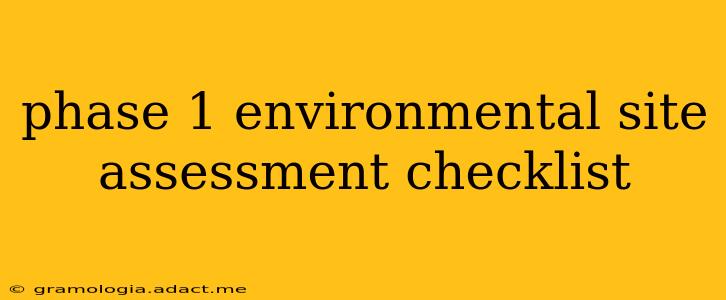A Phase 1 Environmental Site Assessment is the initial step in determining potential environmental contamination on a property. This crucial process involves reviewing historical records, conducting a site reconnaissance, and interviewing stakeholders to identify potential environmental concerns. Failing to conduct a thorough Phase 1 assessment can lead to significant legal and financial liabilities later on. This checklist will guide you through the essential elements of a comprehensive Phase 1 ESA.
Understanding the Purpose: The primary goal of a Phase 1 ESA is to identify recognized environmental conditions (RECs) that may indicate past releases of hazardous substances. This helps determine whether further investigation (Phase 2) is necessary. It doesn't involve actual sampling or testing; that comes later.
Key Components of a Phase 1 Environmental Site Assessment
This checklist outlines the key areas to cover during your Phase 1 ESA. Remember, this is a guide, and the specifics may vary based on the property's location, history, and intended use. Always consult with a qualified environmental professional for a complete and legally compliant assessment.
1. Historical Records Review:
- Title Search and Deed Review: Examine property records to uncover past ownership, land use, and any recorded environmental incidents.
- Tax Assessor Records: Review tax assessment records for details on property usage and structures over time.
- Sanborn Maps: Analyze historical Sanborn fire insurance maps to identify past building locations and land uses.
- Aerial Photographs: Examine aerial photos to observe changes in land use and the presence of any structures or features over time.
- Governmental Records: Research databases at the local, state, and federal levels (e.g., EPA databases, state environmental agencies) for reported releases, spills, or contamination incidents.
- Local Regulatory Agency Inquiries: Contact local environmental agencies to obtain information on permits, violations, or any known environmental issues related to the property.
2. Site Reconnaissance:
- Visual Inspection of the Property: Observe the site for any signs of past or present environmental contamination, including:
- Obvious contamination: Spills, staining, unusual odors, dead vegetation.
- Abandoned structures or equipment: Potential sources of past hazardous waste.
- Underground storage tanks (USTs): Identify any visible evidence of USTs.
- Waste disposal areas: Identify any areas that may have been used for waste disposal.
- Interviews with Site Personnel and Neighbors: Gather information from current and former occupants, neighbors, and local residents to learn about past activities and potential environmental concerns.
3. Interviews and Data Gathering:
- Current Occupants: Discuss current activities and any potential environmental concerns.
- Past Occupants/Owners: If possible, interview previous owners or occupants to obtain information about past activities.
- Neighbors: Inquire about any knowledge of past industrial activities, spills, or unusual occurrences on or near the property.
- Local Experts: Consult with local experts, such as environmental consultants or former employees of companies that operated on the site, to gather additional historical information.
Frequently Asked Questions (PAAs)
What is the difference between a Phase 1 and a Phase 2 Environmental Site Assessment?
A Phase 1 ESA is a non-invasive assessment involving historical research and site reconnaissance to identify potential environmental contamination. A Phase 2 ESA involves intrusive investigation such as soil and groundwater sampling to confirm or rule out contamination.
How long does a Phase 1 Environmental Site Assessment take?
The duration of a Phase 1 ESA varies depending on the property's size, complexity, and history. Simple properties might be assessed within a few weeks, while more complex sites could take several months.
Who conducts a Phase 1 Environmental Site Assessment?
A Phase 1 ESA should be conducted by a qualified environmental professional with expertise in environmental site assessments. These professionals are often certified environmental assessors.
Is a Phase 1 Environmental Site Assessment required for all property transactions?
While not always legally mandated, a Phase 1 ESA is highly recommended, especially for commercial or industrial properties, before purchasing, leasing, or developing a site. It protects buyers from unforeseen environmental liabilities.
What are Recognized Environmental Conditions (RECs)?
RECs are the findings of a Phase 1 ESA that suggest past releases of hazardous substances may have occurred on a property. Identification of RECs typically triggers the need for a more detailed Phase 2 assessment.
How much does a Phase 1 Environmental Site Assessment cost?
The cost of a Phase 1 ESA varies greatly depending on property size, location, complexity, and the level of historical research required. It is best to obtain quotes from several environmental consulting firms.
By using this checklist and addressing the common questions surrounding Phase 1 ESAs, you can ensure a more thorough and effective assessment process, minimizing environmental risks and protecting your interests. Remember to always consult with a qualified professional for your specific needs.
